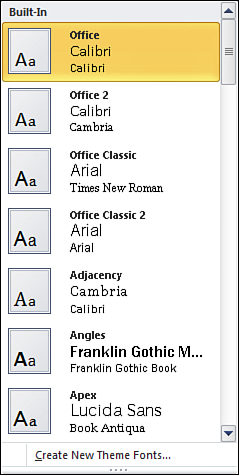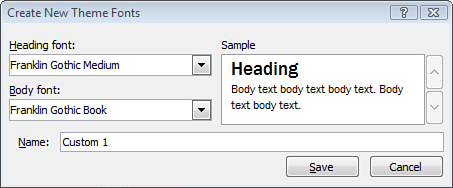2. Customizing Theme Fonts
Although each theme comes with coordinating fonts, you can apply new fonts to your presentation—or create your own.
Applying New Theme Fonts
To apply new theme fonts, follow these steps:
1. | Click the Fonts button on the Design tab. The font gallery displays.
|
2. | Pause
your mouse over each font pair to preview on your presentation. The
font gallery shows two fonts in each pair. The first is for headings
(both titles and subtitles) and the second is for body text, which
includes all text other than title text such as text in tables, charts,
and so on.
|
3. | Choose the font pair you prefer from the font gallery, shown in Figure 3.

|
Creating New Theme Fonts
To create new theme fonts, follow these steps:
1. | On the Design tab, click the Fonts button.
|
2. | In the font gallery, click Create New Theme Fonts to open the Create New Theme Fonts dialog box. Figure 4 illustrates this dialog box. If you enable multiple language support, this dialog box might contain additional options.

|
3. | Select a new Heading Font and a new Body Font from the drop-down lists. The Sample box previews your selections.
|
4. | Enter a name for your custom font pair.
|
5. | Click the Save button. Your new custom font pair now displays in the font gallery (see Figure 5).

|
|
Be
sure that any new fonts you apply are readable on your slides. Theme
fonts are designed to be easy to read with all theme color schemes.
|
Editing Custom Fonts
To edit custom fonts, follow these steps:
1. | Right-click
the custom font pair you want to edit in the font gallery, and choose
Edit from the shortcut menu. The Edit Theme Fonts dialog box displays,
which is nearly identical to the Create New Theme Fonts dialog box.
|
2. | Make your changes in the Edit Theme Fonts dialog box.
|
3. | Click the Save button.
|
|
To delete custom fonts, right-click the custom font
pair in the font gallery, and choose Delete from the shortcut menu.
Click Yes when prompted to confirm. Your custom fonts no longer display
in the font gallery.
|